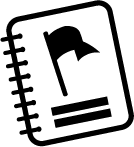Please set aside several minutes to attempt this exercise the first time. For the first practice, have the attached Progressive Muscle Relaxation Chart so you can follow the directions closely and make notes of any particular body areas that seem to be more prone to stress related tension; you will experience this as tightness or soreness. In later practice sessions, most likely you will not need your chart for the exercise.
Make sure that you are in comfortable clothing and seated in a comfortable chair when you begin practicing this technique and that you use your controlled breathing technique. In addition, review the following precautions:
- If you have a medical condition or physical injury, please consult your doctor before attempting this exercise.
- Avoid practice if you have just consumed a heavy meal.
- Do not practice if you have consumed alcohol.
Review the following steps before beginning this exercise. Sit comfortably in a chair or lie down on a comfortable surface. Then, move step-by-step slowly while using your relaxed breathing technique. Take your time in completing the exercise. Do not move to the next step until you have reviewed a given body part and are able to identify it as relaxed or you are able to release tension in that body part. When creating tension, hold the body part tense for approximately five seconds followed by 10 seconds of relaxation. At exercise end, allow yourself time to become fully alert before rising from the chair.
For each step/body part:
Create Tension:
hold for ~5 seconds.
Relax:
~10 seconds
Take Notes:
Record any notes about particular tension, stress, tightness, or soreness
-
Right hand and forearm
Make a fist with your right hand.
Relax your hand and forearm.
-
Right upper arm
Bring your right forearm up to your shoulder to “make a muscle.”
Relax your upper arm.
-
Left hand and forearm
Make a fist with your left hand.
Relax your hand and forearm.
-
Left upper arm
Bring your right forearm up to your shoulder to “make a muscle.”
Relax your upper arm while slowly releasing your breathe to a count of three.
-
Forehead
Raise your eyebrows as high as they will go, as if you were surprised by something.
Relax your forehead.
-
Eyes and cheeks
Squeeze your eyes tight shut.
Relax your eyes and cheeks.
-
Mouth and jaw
Open your mouth as wide as you can, as you might when you’re yawning.
Relax your mouth and jaw.
-
Neck (be careful as you tense these muscles)
Face forward and then pull your head back slowly, as though you are looking up to the ceiling.
Relax your neck and allow your face to return to normal position.
-
Shoulders
Tense the muscles in your shoulders as you bring your shoulders up toward your ears.
Relax your shoulders while slowly releasing your breathe to a count of three.
-
Shoulder blades and back
Push your shoulder blades back, trying to almost touch them together, so that your chest is pushed forward.
Relax and allow shoulder blades to return to normal position.
-
Chest and stomach
Breathe in deeply, filling up your lungs and chest with air.
Exhale slowly.
-
Hips and buttocks
Squeeze your buttocks muscles.
Relax your buttocks muscles.
-
Right upper leg
Tighten your right thigh.
Relax your thigh.
-
Right lower leg (do this slowly and carefully to avoid cramps)
Pull your toes toward you to stretch the calf muscle.
Relax the toes and calf.
-
Right foot
Curl your toes downward.
Relax your toes
-
Left upper leg
Tighten your left thigh.
Relax your thigh.
-
Left lower leg (do this slowly and carefully to avoid cramps)
Pull your toes toward you to stretch the calf muscle.
Relax the toes and calf.
-
Left foot
Curl your toes downward.
Relax your toes.
Adapted from: Center for Clinical Interventions. (n.d.) Progressive muscle relaxation.


